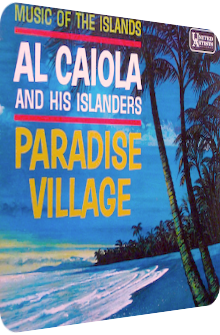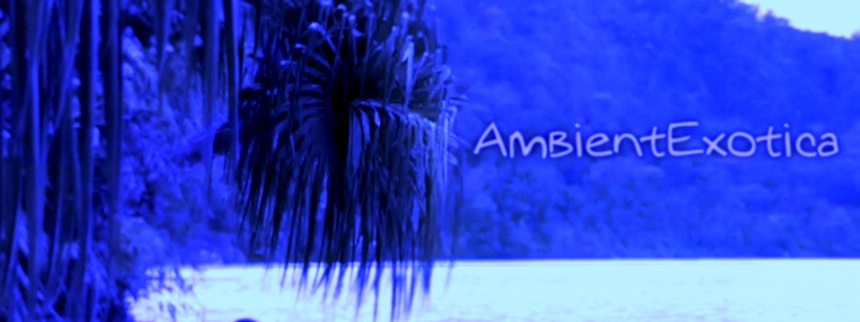
Al Caiola
Paradise Village
1963
Conductor and guitarist Al Caiola (born 1920) has permeated many a genre's boundaries: Jazz, Country, Rock. And Exotica. He was a former session musician who appeared in uncredited form on albums by Andre Kostelanetz and Percy Faith. Paradise Village, released in 1963 on United Artists Records, sees him collaborate with His Islanders, a group of session musicians who, as it turns out, ennoble Caiola's darker and decidedly accessible guitar chords with magnanimous organ molecules, ever-silky brass undulations, freedom flutes, steel guitar prowess and harp creeks among many other ingredients. 12 instrumentals made it onto the LP, eleven of them interpretations of Exotica gold standards and Pacific compositions, with one unique tune envisioned by the lead guitarist himself.
While the liner notes neglect to mention the names and exact number of the involved musicians, there is indeed one valuable tidbit of information featured on the back which I quote in its entirety: "Late in 1962 Caiola made a flying trip to Europe, where, in just two weeks he appeared in France, England and Italy. While flying home, Al completed the arrangements for his album, and within twenty-four hours after his plane landed he was in a recording studio converting Paradise Village from a series of orchestrations into one of the finest albums he has ever made." These lines not only tell you something about his work ethos, but also give the impression of Paradise Village being both hastily compiled and the end result of a horrible jet lag. And indeed: Caiola could really be the achilles heel of this record, as crazy and audacious this may seem to you at first. So let's face it: Paradise Village is a dud, right? Not at all, especially not in such an absolutist kind of rhetorical question! Why the album still has some superb arrangements to offer will be explicated below. Genius and insanity are oftentimes very close in that very village.
In sync with the front artwork and the title of the LP, Al Caiola’s first offering is an interpretation of George Forrest’s and Robert Wright’s Stranger In Paradise. The first tune is unsurprisingly the most essential one on each music-related work, and so the guitarist and his session musicians try to induce aural timbres that match the nocturnal scenery of the front artwork. Whether this is by accident due to the possibility that the artwork had not yet been finished when the recording session took place or whether this aura is specifically designed, rest assured that Stranger In Paradise rarely sounded more forsaken and forlorn than in this interpretation. And this is a good thing. The field recording of chirping birds of paradise may be a claim to the contrary of what I have just explained, even more so since such tropical scents usually boost the liveliness and virtual vicinity of a tune, but right after this short dawn chorus and the following mélange of whirling Space-Age organ washes plus flute splinters, Caiola’s dark guitar in minor is astutely united with legato flutes, steel guitar coils and diffuse vibraphones. These devices all bolster the atmosphere, but there is a certain lachrymosity or even threnody injected into each tone, creating a maudlin melancholia which stands in sharp contrast to the exotic opening phase. Exotica does not have to be enchanting and flamboyant all the time, and Al Caiola proves here how to arrange a tune in order to create an ambiance of twilight.
Tiara Tahiti by Norman Newell and Phil Green then breaks the spell of mawkish magic and leads the listener to the Tropics thanks to its Calypso-esque structure sans steel pans. From the Bert Kaempfert-like pointillistic muted horns over the Brazilian maracas and golden harp cascades to the downwards spiraling flute tittles in tandem with Caiola’s opaque guitar globs, this tune is much more rooted in a positive, less dreamy way of handling life. Despite the large instrumental pool and the many textures, Tiara Tahiti does neither feel overcrowded nor exhilarative.
Curiously enough, Hugh Williams’ and Jimmy Kennedy’s solemn Red Sails In The Sunset is transfigured into a tropical tour here and glows much stronger than the precedent material. Launching with transcendental harp spirals awash with light and the cries of seagulls, a bassoon melody gets entangled with blurry billows of vibraphones. This opening vignette is pure gold and Ambient Exotica indeed. After roundabout 25 seconds, this dreamy experience is over, but a solacing amount of steel guitars, Pagan flutes and wondrously liquid celestas altogether make the main melody come to new life. The focus on a static number of instruments rather than the introduction of multitudinous ingredients helps carving out the melodies very much; a poeticized take on this classic about freedom on the open sea.
The following Hawaiian Punch is written by Al Caiola himself and stands on the post-Prohibition soil of Manhattan by the means of its brassy-jazzy 6/8 rhythm which then forcefully clashes with positively elasticized steel guitar licks and warbled flutes. The resulting punch is an awkward one, the balance is simply lackluster, those reeds and brass instruments destroy the paradisal aura, the tropical ingredients feel… de trop. I rather bathe in Richard Rodgers’ and Oscar Hammerstein II.’s Bali Ha’i, the well-known Exotica gold standard which is hued in grayer colors on Caiola’s rendition with less blazing cavalcades of colors. The sad flute melody immediately turns dreamy, but the main sequence on the guitar is a bit too thin and dark for my liking, whereas I am okay with the steel guitar thicket. The murky clarinet is mixed too loudly, even though the genteel brass carpets in the background as well as the Korla Pandit-like crystalline pipe organ inject a nice dose of Space-Age in this faux-Polynesian artifact. Side A ends with Acker Bilk’s and Robert Mellin’s Stranger On The Shore whose first part is coated in a mellifluous harbor vista filled with seagulls, polyphonous rhythm guitar flashes and Caiola’s echoey lead guitar. The second part sees additional steel guitars and a hyper-spacey zither that has to be heard to be believed! Closing the circular nature, the field recording returns until side A ends for good.
Carpe nocturne – Frank Loesser’s and Alfred Newman’s Moon Of Manakoora kicks off side B in a great version. The main melody is always recognizable, oscillating between steel guitar and trumpet pairings to fully fleshed horn washes of the silkened kinds. Phantasmagoric harp rivers add another touch of exoticism, delicately trembling sanguine organs remind of the night-lit setting, only the prominent rhythm construction of stumbling shakers and balmy hi-hats is irritating and presses an element of impetuosity onto the scene that is simply unfitting. Al Hoffman’s, Charles E. King’s and Dick Manning’s Hawaiian Wedding Song suffers from an even faster, more uplifting rhythm, but this can also be seen as the departure to new shores, and since all other elements are equally bubbling and lilting, especially so the luminous iridescence of the Space-Age organ shards and the towering steel guitar airflows, I am, at the end of the day, d’accord with all of these peculiarities.
While Carl Sigman’s and Robert Maxwell’s Ebb Tide first establishes an enormously soothing ambience via gentle ocean waves, steel guitar maelstroms, Pagan flutes plus Al Caiola’s work on the main melody and then lets this hammock-friendly aurora clash with spiky organ shards that would make Korla Pandit proud yet again, Danny Hamilton’s, Hugo Winterhalter’s and Mack David’s Diamond Head is a swinging midtempo tune with bugging alpenhorn scents akin to Billy Vaughn’s horrific album Blue Hawaii (1959) which destroy even the beautiful complexion of the steel guitars, harps and steamy drums. This over-the-top mentality does not help. Avoid. Norman Petty’s Almost Paradise, however, is a gem! Soothing guitars, harp rivers and those quirkily translucent organ presets mesh with carefree flute tones and the mildest of all brass sequences. Being one of the best tunes and awash with yellow-orange colors, Almost Paradise is a revelation in the given context. The finale is an interpretation of Bronisław Kaper’s and Paul Francis Webster’s Follow Me and is equally exotic and dreamy. A tad more uplifting, the fusion of the crazy organ textures with the horns is pure genius and makes for a highly interesting textural thicket, all the while the clinging wind chimes as well as the tropical flute tones make this a particularly enthralling critter that sits somewhere in-between an Oriental timbre and Polynesian isles. A wonderful epitome of a closing track.
Let me phrase it this way: if Paradise Village was an actual location on some languorous island, I would love to reside there, spend my days walking at the beach, going to hukilaus and visit the next tiki bar which is always in close proximity anyway. It is a dream come true. That is, until I spot the pesky neighbors aka the few stylistic choices that do not work well on the album. First and foremost, what happens to Al Caiola and his guitar over the course of the 12 tracks? He is always in the spotlight, but his way of strumming is all too laid-back, never encapsulates the least bit of eclecticism – the latter of which is, at times, even applicable in Exotica records – and remains in the same area texture-wise. Imagine what skilled guitarists like Barney Kessel, Jerry Byrd and Dick Dale could have done in and with these surroundings. Here we have the curious case of an album which is still skillfully arranged and bewitching and whose front artwork is an apt choice as it is mirrored in the music, but the bold letters reading "AL CAIOLA" do not even reveal half of the truth, namely that the unmentioned session musicians are the actual stars!
Especially the Space-Age nebulae of the organist are enormously successful, always wonky, with embedded slivers of craziness and dissonance, yet greatly texturized. They not only admix another genre to this otherwise clear cut Exotica item but augment the perception of experiencing a night somewhere in the tropics. The harps are liquedous, the flutes either soothing and profound or cheerful and flying around, the brass instruments are neither acidic nor syrupy rather than exactly right… until Diamond Head appears where they burst at the seams and remind of the German-Austrian-Swiss Schlager movement, hence utterly destroying the magic. Missteps like these face astonishing streaks of luck: both Almost Paradise and Follow Me occur right after Diamond Head and close the album with Ambientscapes and a midtempo exoticism to die for.
Likewise, the opener Stranger In Paradise is a particularly interesting interpretation due to its gloomier, more confined and pondering nature, and let me not forget the first 25 seconds or so of Red Sails In The Sunset; another prelude to die for… again. Consider the various field recordings and the fitting material, and you've got a pretty good idea about paradise with a few shadier elements woven in so that an overabundance of joy won't kill anyone. Paradise Village is available on LP and has been digitally reissued by Smith & Co. in 2011, as usual with an entirely different cover, but in pristine sound quality. Book your trip at iTunes or Amazon MP3.
Exotica Review 215: Al Caiola – Paradise Village (1963). Originally published on May 11, 2013 at AmbientExotica.com.
